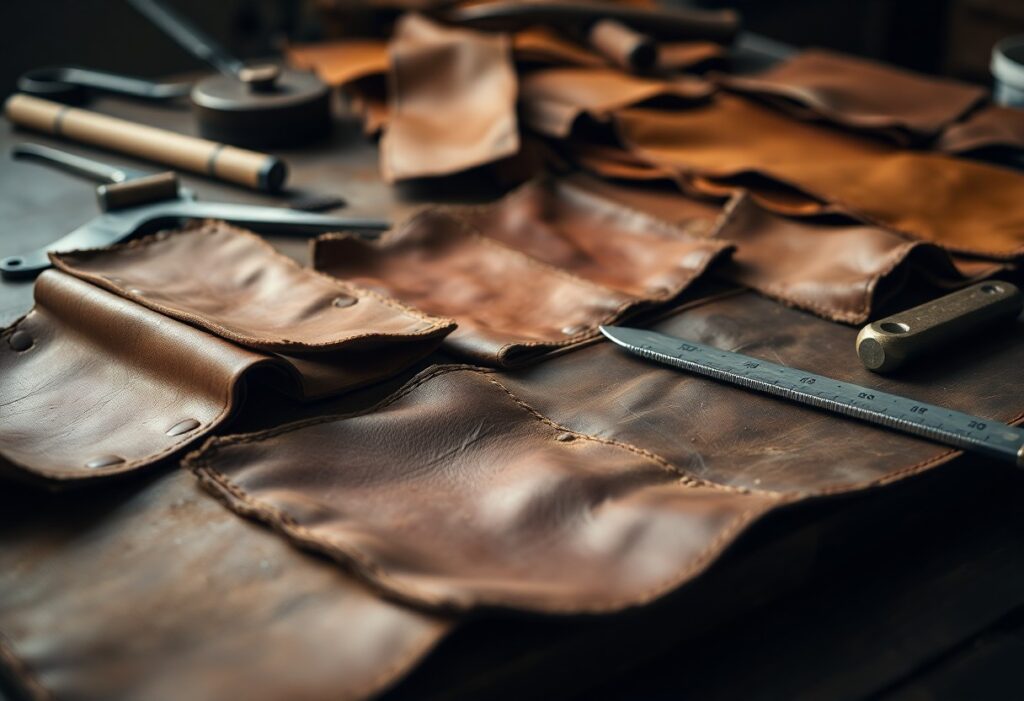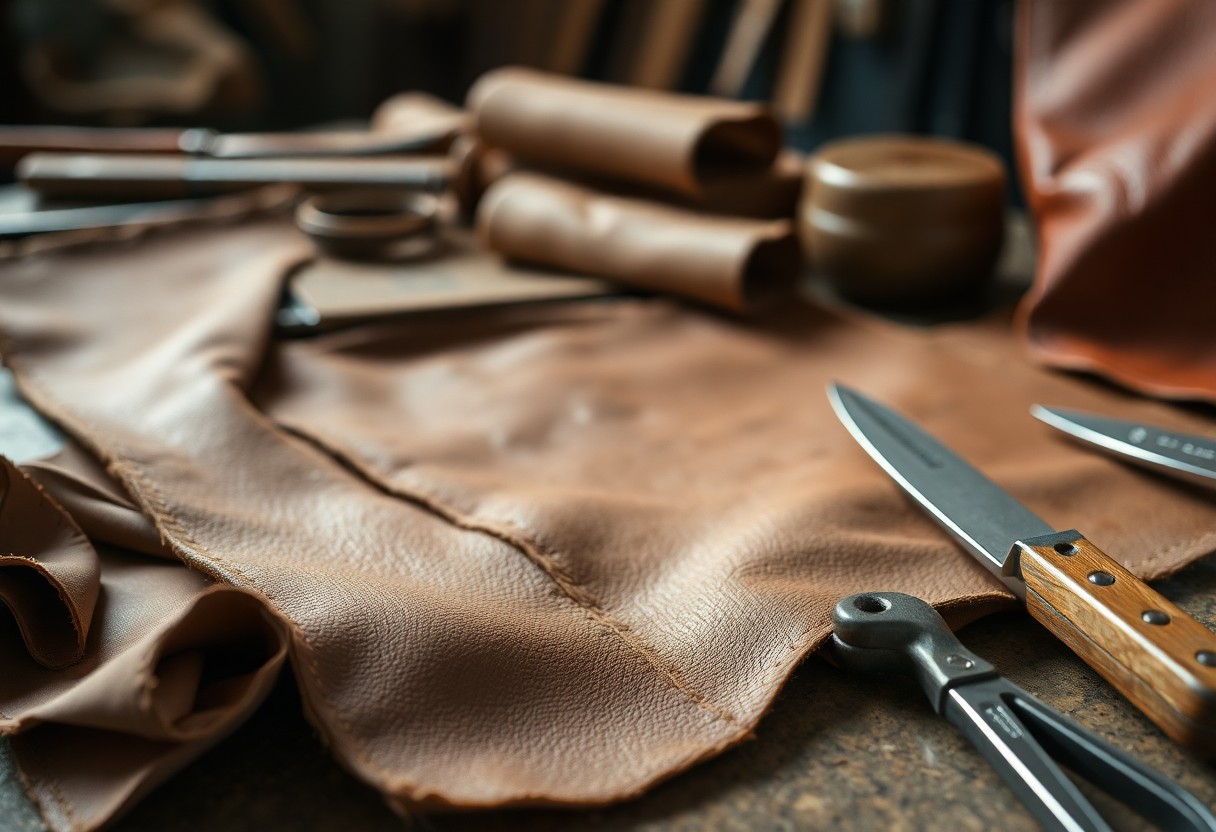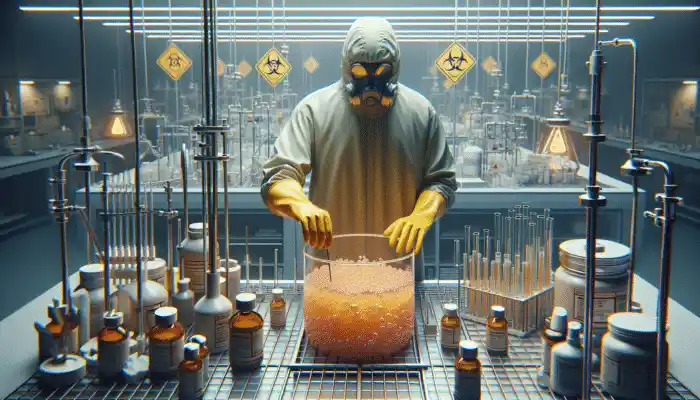
The evolution of leather tanning has transformed the industry, resulting in a sophisticated process that profoundly impacts the quality and longevity of your leather goods. Various tanning methods, such as chrome tanning, vegetable tanning, and chrome-free methods, produce distinctly different characteristics in leather. These characteristics influence critical attributes like durability, water resistance, texture, and color retention. The tanning journey begins with raw hides and progresses through several essential stages. Understanding these methods equips you to make informed choices about leather quality while also considering the environmental footprint of each approach, as some methods are notably more eco-friendly than others.
Discover the Different Leather Tanning Techniques to Enhance Your Products
In the realm of leather production, a multitude of tanning methods are utilized to convert raw hides into high-quality leather. The primary techniques, including chrome tanning, vegetable tanning, and chrome-free tanning, each have unique processes and outcomes. This comprehensive guide aims to illuminate the intricacies of each method, empowering you to select the one that aligns best with your specific leather requirements and preferences.
| Method | Characteristics |
| Chrome Tanning | Fast, water-resistant, 85% of global production |
| Vegetable Tanning | Natural, eco-friendly, 10% of production |
| Chrome-free Tanning | Environmental-friendly, 5% of production |
| Combination Tanning | Blends multiple methods for unique properties |
| Aldehyde Tanning | Specialized process for specific applications |
Gain Insight into the Chrome Tanning Technique and Its Applications
The chrome tanning process utilizes chromium (III) salts to create leather that is not only soft and flexible but also highly sought after for a variety of applications. This method produces leather that is remarkably water-resistant and easily absorbs dyes, making it a preferred choice among manufacturers. One of the standout features of chrome tanning is its efficiency, typically taking just 24-48 hours to complete, which is crucial for meeting the demands of mass production.
Explore the Timeless Tradition of Vegetable Tanning
As one of the oldest and most traditional methods, vegetable tanning relies on natural tannins extracted from tree bark and leaves. This method is celebrated for its ability to produce leather that ages gracefully, developing a rich patina over time while being biodegradable. Different types of vegetable tanning, including those utilizing oak bark, chestnut, and mimosa extracts, contribute to the unique characteristics of the finished leather. This meticulous process can take about 4-6 weeks, resulting in leather that is often firmer and more structured when compared to its chrome-tanned counterparts.

In-Depth Analysis of the Leather Tanning Process from Raw to Finished
Transforming raw hides into premium finished leather is a structured and systematic process. Here, we provide a comprehensive look at each critical step involved, along with its significance in achieving the desired quality in leather products.
Crucial Pre-tanning Steps to Ensure Superior Leather Quality
To achieve optimal leather quality, raw hides go through a series of meticulous preparation steps. This initial phase entails soaking the hides in clean water for 24-48 hours to remove salt and dirt. Following this, a liming process is executed to effectively eliminate hair and fats. Maintaining precise pH control during these stages is essential to prevent any potential damage to the hides and to ensure a successful tanning process.
Key Techniques in the Primary Tanning Phase
The pretanning phase is marked by deliming and pickling, which prepare the hides for the primary tanning agents. The most widely used method is chrome tanning, which employs chromium sulfate and can yield leather in as little as 24 hours. On the other hand, vegetable tanning, which utilizes natural tannins, extends the process significantly to approximately 20-60 days.
A critical aspect of the tanning process is temperature control. Chrome tanning typically occurs at temperatures between 35-40°C, while vegetable tanning is conducted at cooler temperatures of 20-25°C. Consistent monitoring of pH levels is vital to avoid compromising the leather and to ensure optimal absorption of tanning agents.
Advanced Leather Treatment Techniques for Enhanced Longevity
There are numerous techniques available to enhance the properties of your leather. From surface finishing to deep penetration treatments, each method serves a specific purpose. With the right treatment, you can extend the lifespan of your leather by up to 50% while significantly enhancing its resistance to water, heat, and wear.
Diving into Surface Treatments for Improved Leather Performance
Surface treatments applied to leather can encompass various processes such as waxing, buffing, and protective coatings. These techniques can increase water resistance by up to 70% and allow you to select between a glossy or matte finish according to your preference. Moreover, surface treatments are essential for safeguarding leather against UV damage and everyday wear and tear, thereby prolonging its aesthetic appeal and functionality.
Understanding Dyeing Techniques for Color and Durability Enhancement
Your leather can absorb various types of dyes at different depths. The aniline dyeing technique, for example, penetrates deeply into the leather, while surface dyeing allows for a more controlled color application. The dyeing approach you choose will have a direct impact on both the visual appeal and durability of the leather.
Furthermore, the dyeing method significantly determines the final attributes of the leather. Drum dyeing can achieve up to 95% color penetration, whereas spray dyeing provides enhanced precision in color control. It’s important to consider that natural dyes are eco-friendlier but may fade roughly 20% faster than their synthetic counterparts.

Understanding the Critical Quality Factors in Leather Production
The quality of leather is shaped by a multitude of interconnected factors throughout the entire processing chain. Gaining insight into these elements is crucial for achieving superior results in both leather selection and maintenance. The tanning method, hide quality, and processing parameters all play pivotal roles in defining the final characteristics of the leather. By mastering these factors, you empower yourself to evaluate leather quality effectively according to your specific requirements.
Choosing Raw Materials for Optimal Leather Quality
When selecting raw materials, prioritizing the condition of the hides and the animal source is essential. The quality of your raw materials directly influences the properties of the finished leather. The finest hides come from healthy animals and are characterized by minimal surface defects. Look for thickness consistency and absence of parasitic damage. It’s crucial to select materials based on their intended application, as different uses demand specific hide characteristics.
Significance of Processing Parameters in Quality Assurance
There is a direct relationship between processing controls and the overall quality of leather. Maintaining strict control over pH levels, temperature, and chemical concentrations is vital. The tanning duration generally spans from 24 to 48 hours, with temperatures kept between 35-40°C. Your meticulous attention to these parameters ensures consistent leather quality throughout the entire process.
Such meticulous control should extend through every stage of production. Monitoring moisture content (ideally 45-55%), maintaining appropriate drum speed during tanning, and ensuring accurate chemical dosing are all critical. Additionally, the drying conditions must be carefully controlled to prevent any damage to the leather. A thorough focus on these parameters leads to higher quality finished products.
Expert Strategies for Achieving Superior Leather Treatment Results
Not all leather treatment processes yield the same level of quality. It’s crucial to focus on temperature control, chemical balance, and timing precision throughout the tanning process.
- Regularly monitor pH levels
- Maintain consistent temperature
- Adhere to exact chemical ratios
- Document each step meticulously
Being attuned to the signs of proper tanning will enable you to achieve high-quality finished leather.
Techniques for Process Optimization to Enhance Outcomes
To achieve optimal results, managing your tanning environment is essential. Keep your workspace at temperatures of 20-25°C and maintain humidity levels between 45-55%. Ensure that your chemical solutions are fresh and precisely measured. Routine maintenance of your equipment is vital for ensuring consistent results.
Upholding Quality Standards in Leather Care and Maintenance
The quality of leather heavily depends on your storage conditions and handling procedures. Store your leather in a dry, cool area away from direct sunlight to maintain its integrity. Regularly check the moisture content and rotate your leather stock every 30 days.
Monitoring the entire process is essential for maintaining quality standards. Your routine checks should include pH testing, physical inspections, and moisture content analysis. Document all findings and adjust your procedures based on the results. Consistent quality control allows you to identify potential issues before they negatively impact your final product.

Comparative Analysis of the Advantages and Disadvantages of Tanning Methods
To fully grasp the complexities of leather tanning, it is essential to compare the various methods, weighing their respective advantages and disadvantages. Below is a detailed comparison of the primary tanning techniques:
| Pros | Cons |
|---|---|
| Chrome tanning: Fast processing, cost-effective | Chrome tanning: Environmental concerns, potential disposal issues |
| Vegetable tanning: Eco-friendly, natural process | Vegetable tanning: Time-consuming, requires higher water usage |
| Chrome-free tanning: Environmental safety, good quality | Chrome-free tanning: Complex process, higher costs |
| Combination tanning: Versatile properties | Combination tanning: Challenging quality control |
Financial Considerations of Leather Tanning Decisions
Decisions regarding leather tanning methods can greatly influence your production costs. Chrome tanning offers 85% cost efficiency compared to vegetable tanning, while chrome-free methods often lead to increased expenses by 20-30%.
Quality Impact of Tanning Decisions on Leather Products
The quality of even the finest leather can be significantly affected by poor tanning choices. The selected tanning method directly impacts crucial attributes such as durability, water resistance, and texture.
For instance, leather treated through chrome tanning exhibits superior water resistance and flexibility, while leather tanned using vegetable methods is known for its better aging characteristics and the development of a unique patina over time.
Key Takeaways on Leather Tanning and Treatment Techniques
From the insights shared, it’s clear that the various leather tanning and treatment methods play a crucial role in determining the quality and characteristics of your leather products. The decision between chrome, chrome-free, or vegetable tanning will significantly influence your leather’s durability, texture, and environmental ramifications. Additionally, the dyeing technique you select—whether it’s aniline or crust—will impact your leather’s color depth and aging properties. Finally, the choice of finishing applied—be it full grain, corrected grain, or top-coated—sets the standard for appearance, breathability, and maintenance needs. Understanding these processes enables you to make informed and strategic decisions regarding your leather purchases and care practices.
Your Leather Tanning Questions Answered: FAQs
Q: What are the key differences between chrome tanning and vegetable tanning?
A: Chrome tanning employs chromium salts to create soft, water-resistant leather that is processed quickly and economically, accounting for 85% of global leather production. In contrast, vegetable tanning uses natural tannins sourced from tree bark and leaves, requiring a longer processing time but yielding leather that develops character with age. While vegetable-tanned leather is more eco-friendly in terms of disposal, it can be more susceptible to staining than chrome-tanned options.
Q: How does aniline dyeing influence leather quality and appearance?
A: Aniline dyeing involves immersing leather in dye baths that penetrate deeply into the material. This method results in uniform color throughout the leather, ensuring excellent color retention. Modern aniline-dyed leather is often dyed partially rather than completely, which allows for a lighter middle layer. This technique enhances the leather’s stability while providing good color depth on the surface.
Q: What distinguishes full grain leather from corrected grain leather?
A: Full grain leather retains its natural surface without sanding or artificial overlays, showcasing natural pores and the strongest fiber structure, allowing it to be restored when scuffed. Corrected grain leather, on the other hand, undergoes sanding and is treated with a plastic layer, making it easier to clean and maintain but often lacking breathability and may crack over time without the means for repair.
The Article Guide to leather tanning and treatment methods processes types and their impact on quality appeared first on My Shoes Finder
The Article Leather Tanning: Methods, Processes, and Quality Impact Guide Was Found On https://limitsofstrategy.com
References:
Leather Tanning: Methods, Processes, and Quality Impact Guide





Your exploration of leather tanning methods provides valuable insights, especially considering how each technique can radically alter the end product’s qualities. I’ve always been intrigued by the balance between craftsmanship and environmental responsibility in this industry. For instance, while chrome tanning is often praised for its efficiency and speed, it raises concerns regarding the toxic byproducts it generates. Do you think the quicker turnover justifies the environmental impact, especially given the rising consumer awareness around sustainability?
You raise an important point about the balancing act between efficiency in leather tanning and its environmental implications. While chrome tanning offers speed and durability, the trade-off with toxic byproducts can’t be ignored. Many consumers today are understandably more conscious of what goes into the products they buy, prompting a shift toward more sustainable practices.
You bring up a crucial point about the tension between efficiency in leather production and environmental responsibility. Chrome tanning certainly speeds up the process, but the reality is that those toxic byproducts can’t be overlooked, especially as more consumers start to ask tough questions about sustainability.
You raise an important issue that many of us are starting to grapple with. It’s true that while chrome tanning offers speed, the environmental impact often feels like an uncomfortable truth lurking beneath the surface. When consumers demand more transparency about where and how products are made, it becomes vital for the industry to adapt, finding ways to balance efficiency with ecological responsibility. Exploring alternatives, like vegetable tanning or other innovative techniques, can potentially lead to less harmful byproducts and greater sustainability. It’s a complex situation, and fostering this conversation is a crucial step toward driving meaningful change in leather production practices. What are your thoughts on how consumers can play a role in demanding such changes?
You’ve hit on an important conflict that’s becoming hard to ignore. The speed and cost-effectiveness of chrome tanning appeal to manufacturers, but it forces us into an uncomfortable corner where the environmental impact is brushed aside.
You’re right on the money with the whole craftsmanship vs. environmental responsibility dance. It’s a bit like trying to perfect a soufflé while managing a small kitchen fire. Chrome tanning definitely speeds things up, but the toxic lasagna it leaves behind is a whole other can of worms.
I found your insights into leather tanning really fascinating, especially the emphasis on how different methods can influence the final product’s durability and environmental impact. Having worked with leather in a few DIY projects, I’ve come to appreciate not just the craftsmanship but also the thought that goes into choosing the right tanning process.
It’s great to hear you’ve found a practical side to leather tanning through your DIY projects. The choice of tanning method really does shape the character of the leather, doesn’t it? It’s interesting how techniques like vegetable tanning give a distinct look and feel while also emphasizing a more sustainable approach. On the flip side, chrome tanning is quicker and often more durable, yet it raises significant environmental concerns.
You’re spot on about how the choice of tanning method shapes the character of the leather. I’ve dabbled in both vegetable and chrome tanning for various projects, and it’s fascinating how each method can bring out different qualities in the leather. With vegetable tanning, the aging process seems to enhance the leather’s beauty over time—those rich patinas tell a story, you know?